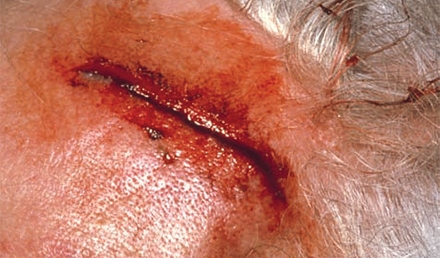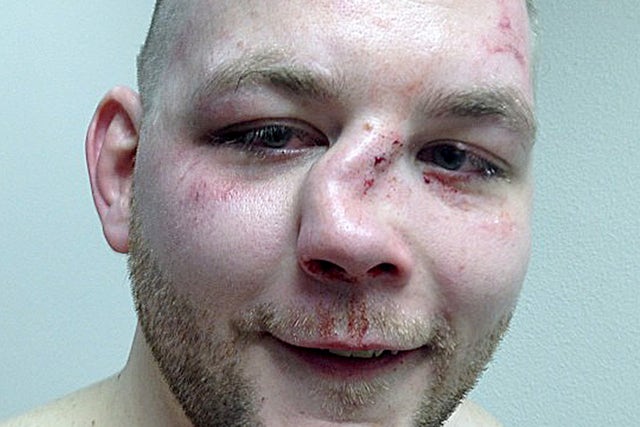Management of Facial Injuries
Published (updated: ).
Scalp Injuries

Scalp wounds bleed a lot. The scalp contains a myriad of blood vessels. Medics should ensure the scalp and the back of the head have been examined completely. A bleeding wound to the back of the head in the scalp that is undiscovered could result in bleeding that continues to bleed throughout transport. Discovery of a scalp or head wound can be made either through a focused history and physical exam, rapid trauma assessment, secondary survey. A finding of bleeding should be immediately managed with direct pressure. During the examination of the patient’s head, the medics may not find bleeding but may instead find crepitus or tenderness. A finding of tenderness could be associated with a number of injuries, including a hematoma. A hematoma could be palpated by the medics when they are looking for bleeding. A hematoma can be found by palpating the skull and discovering a lump.
Injuries to the scalp, head, or face should increase the index of suspicion of the presence of a closed head injury. Closed head injuries are extremely dangerous to patients and can be difficult for medics to see. The problem with closed head injuries is that there may be a bleeding wound inside of the cranial vault and no place for the blood to drain. A buildup of blood in the closed cranial vault will always result in an increase in intracranial pressure. As intracranial pressure increases, changes in the patient’s level of responsiveness will be seen by the medics. The dynamic nature of a closed head injury should always be appreciated by medics as the behavior of a patient with a closed head injury will be dramatic. Loss of consciousness, vomiting, and posturing are examples of the dramatic behavior changes associated with a closed head injury.
Facial Injuries
Facial fractures can present the medics with an interesting airway problem. Broken teeth and bleeding could provide medics with a challenge in regards to airway management. During the primary survey the medics will assess the patient airway if the patient is not alert. Regardless of when the medics assess the face, a bleeding wound will be easily visible. Soft tissue injuries may be closed or open. An open soft tissue injury that is bleeding will need to be managed with direct pressure. Fractures of facial bones can be painful for a patient that is alert and a life-threatening problem for a patient who is unresponsive. The only thing a conscious patient may need is a bag to spit blood into, while an unresponsive patient may require aggressive suctioning to ensure the airway is clear. Broken teeth, mandibular fractures, maxilla fractures, and tooth avulsions all present potential airway problems to an unresponsive patient.
Nasal fractures

Nasal fractures are most commonly associated with blunt force trauma to the nose. Sometimes penetrating injuries are responsible for trauma to the nose. Medics should expect to find bleeding to the nose. The best position for a patient with epistaxis is setting up. The treatment is easy simply pinch the nostrils and hold until the bleeding has stopped. Treating a broken nose that is bleeding is significantly more difficult on a patient who has been immobilized and has to lay flat. The bleeding from the nose will drain into the patient’s mouth and airway. Management of a broken nose that is bleeding for a patient who must be immobilized can be accomplished with suction and positioning. The immobilized patient can be rolled over into a lateral recumbent position and the blood be allowed to drain down the patient’s face but out of the airway. If the Medics must roll the patient in order to keep the airway controlled while the patient is immobilized, they should ensure that the voids created by the long back board have been padded to prevent movement.
Dental Injuries
Blunt force trauma is primarily to blame for injuries to teeth. The blunt force trauma could come in the form of a fistfight or a collision with a steering wheel. Trauma to the teeth will nearly always bleed. Management of a conscious patient with dental trauma can be as easy as having the patient spit blood into a vomit bag. It is when the patient is unresponsive that dental trauma can be more life-threatening. Assessing and clearing an airway with suction if necessary are important interventions for the unresponsive patient. After the airway has been cleared it will be necessary for the medics to continually monitor the airway while in route to the hospital. If possible, the Medics should bring any dislodged teeth with them to the emergency department (despite the fact that. for the most part, hospitals do not have a dentist on call).
Management of facial injuries
All patient interactions begin with a scene size up. During the scene size-up the medics determine the presence of a mechanism of injury. The mechanism of injury may not be very significant, however no matter how insignificant the mechanism of injury provides valuable clues as to the nature of the patient’s injury. Once the medics arrived at the patient’s side, the observations they make will be guided by the primary survey. It is during the primary survey that the presence of a head, neck, face, or neck injury will become apparent. Bleeding injuries to the head neck or face are apparent during the primary survey. A bleeding injury to the face in an unconscious patient could become an airway threat. Unconscious patients with bleeding wounds to the face or neck require immediate intervention during the primary survey. Ventilation and oxygenation are guided by the observations made during the primary survey.
The primary concern during the management of facial and eye injuries is the maintenance of a patent airway. Nasopharyngeal airways are contraindicated in the presence of a facial injury. Facial injuries may require frequent suctioning. The medics should bring broken teeth to the hospital with a patient. Foreign bodies or chemicals to the eyes can be treated with copious amounts of water. Nose bleeds can be controlled by pinching the nostrils.
An injury to the head, neck, or face could result in a patient with altered mental status. The medic should assume the injuries found to the head neck or face are associated with the observation of altered level of consciousness. Further evaluation either during a focused history and physical exam or during the rapid trauma assessment will be required for a patient who is not alert.
